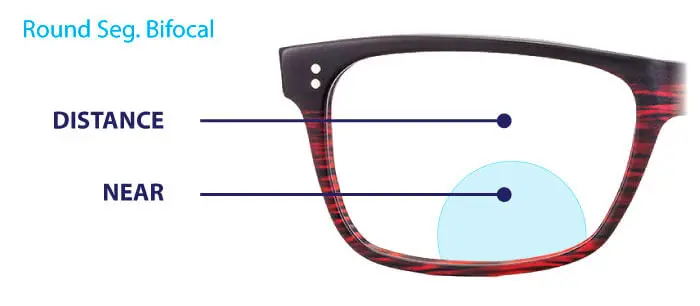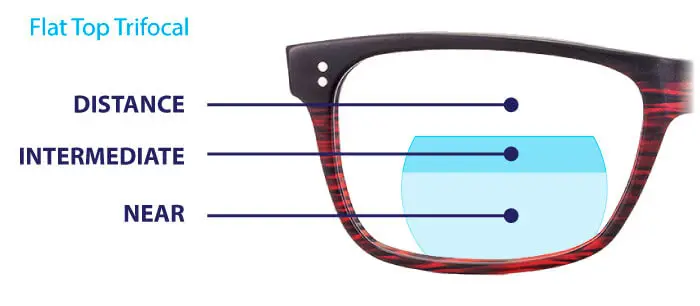
Progressive Lenses - See Clearly At All Distances
As we age the lens of the eye becomes thicker and less flexible, and the surrounding muscle fibres become less elastic, making it difficult to read the small print of newspapers, magazines, books, and text messages. This normal loss of ability to focus at near distances that begins around age 40 is called presbyopia. For some, the blurry near vision encountered as they age may generate anxiety with having to wear the age-defining lined bifocals and trifocals of previous generations. The good news is that progressive lenses are a no-line multifocal lens design that aesthetically appears to be just like a single vision lens. Progressive lenses are considerably more sophisticated and technically advanced than single vision lenses. Accordingly, for them to offer clear, crisp vision at at all distances they need to be measured, customized, and crafted by experienced professionals. Looking for progressive lenses in Edmonton? Visit our Edmonton optometrists and opticians today!
Schedule An Exam Our Optometrists
(780) 473-6123
Multifocal Eye Glasses in Edmonton.
What Are Progressive Lenses?
Progressive prescription lenses are modern multifocal lenses with three benchmark viewing areas: distance-, intermediate-, and near-vision. However, unlike traditional, age-defining bifocals and trifocals, there is no visible line between each viewing area. Instead, they have a seamless, invisible design where the magnification power progressively changes throughout the lens from distance vision (e.g., driving) at the top to near vision (e.g., reading) at the bottom. Advancing from single vision lenses to progressive lenses requires the eyes, brain, and head to recalibrate how they work together to offer the clearest vision at every distance. This recalibration and adaptiation period typically requires 2-3 weeks. New digital freeform progressive lenses, which offer the widest, distortion-free viewing areas, makes adapting to progressive lenses considerably easier. Accordingly, consider investing in digital freeform designs when purchasing progressive lenses.
Schedule A Progressive Lens Fitting
Multifocal Eye Glasses
How Do Progressive Lenses Work?
For any optical device or instrument to be able to focus at multiple focal distances (i.e., near, intermediate, and distance), an element of the overall optical apparatus must move. In cameras, the barrel of the lens moves to adjust the lens closer or further away from the sensor or film to achieve a focused image. With progressive lenses, it is the eye that moves to achieve in-focus images at various distances. Looking out on the horizontal plane provides clear distance (e.g., driving) vision; looking a few degrees downward provides clear intermediate (e.g., computer) vision; and looking downward even further along the plane of the cheeks provides clear near (e.g., reading) vision. The dependency on vertical eye movement, along with head positioning, to make progressive lenses perform properly often requires individuals to adapt to their new optical environment. With daily wear, the average person typically requires 1-2 weeks to adapt to new progressive lenses.
Schedule A Progressive Eye Glass Consult
Progressive Lens Classes
Progressive lenses from manufacturers such as Hoya, Zeiss, and Essilor, are often available at several different classes, each equipped with unique features and capabilities.

Standard Progressives
- Traditional Design
- Narrowest In-Focus Corridor
- Significant Peripheral Distortion
- Restricted Lateral Eye Movevment
- Longest Adaptation Period
- Most Economical Option

Premium Progressives
- Digital Freeform Design
- Moderate In-Focus Corridor
- Moderate Peripheral Distortion
- Improved Lateral Eye Movevment
- Shorter Adaptation Period
- Most Economical Digital Freeform Option

Advanced Progressives
- Digital Freeform Design
- Wide In-Focus Corridor
- Low Peripheral Distortion
- Improved Natural Lateral Eye Movevment
- Short Adaptation Period
- Binocular Harmonization Available
- Can Be Tailored To Lifestyle

Individual Progressives
- Digital Freeform Design
- Widest In-Focus Corridor
- Minimum Peripheral Distortion
- Natural Lateral Eye Movevment
- Shortest Adaptation Period
- Binocular Harmonization Available
- Personally Tailored To You
Multifocal Eyeglasses.
Progressive Lenses Are Not Traditional Bifocals/Trifocals
It is important to note that progressive lenses differ from traditional lined bifocal/trifocal eye glass lenses. Bifocal/Trifocal prescription lenses are a traditional type of multifocal lenses that feature distinct focal zones. Bifocal and trifocal lenses are for individuals who need glasses for distance as well as reading. Instead of having a separate pair of single-vision glasses for each activity, bifocals and trifocals are often a more suitable solution. Unlike single vision lenses, bifocals and trifocals have more than one point of focus or viewing area (distance - driving, intermediate - computer, and near - reading) separated by a distinct, visible line. Bifocals have two points of focus, while trifocals have three. They both represent a traditional multifocal lens design.
Schedule V-eye-P Eyewear Fitting
Modern Multifocal Eye Glasses.
Benefits Of Progressive Lenses
Due to it continuous, seamless design, progressive lenses offer wearers several important functional and aesthetic benefits:
- Progressive lenses provide clear, crisp vision at all focal distances - not just 2 or 3 distinct viewing distances.
- Progressive lenses eliminate the frustrating image shift/jump experienced with bifocals and trifocals. Image shift/jump is when the clarity and apparent position objects abruptly change as the eyes pass across the visible lines in these traditional lenses.
- Because progressive lenses have no visible bifocal lines, they offer a more youthful appearance than traditional bifocals or trifocals. The absence of visual age indicators in progressive lenses helps maintain the philosophy that age is just number.
- Modern digital freeform progressive lenses can be customized to an individual's unique lifestyle preferences.

Multifocal Eye Glasses
Progressive Lenses Customized To Your Lifestyle
Digital freeform progressive lenses can be personalized to an indvidual's unique lifestyle and functional needs. This means that individuals can elect for a progressive lens that is designed to Master 1 or 2 focal lengths rather than a Jack Of All progressive lens that gives balanced performance at near, intermediate, and distance focal points. For example, an individual that spends much of their day undertaking computer work and reading can elect to have progressive lenses crafted that devote more functional area of the lens to the near (i.e., reading) and intermediate (i.e., computer) optical zones, thereby offering greater natural eye movement and minimal peripheral distortion at those distance.
Schedule A Progressive Eye Glass Consult
Modern Multifocal Lenses.
Progressive Lenses: Features To Consider
Not all progressive lenses are created equal. In fact, the customization of progressive lenses and the availability of ancillary features, that provide enhanced performance and/or durability, are only offered by a limited number of manufacturers. Key features to consider when choosing the right progressive lenses for you, your lifestyle, and your budget include:
- Wider corridors/field of views allow for more natural eye movement and promote easy adaptation.
- How do you use your eye most? Would you benefit from a lifestyle-specific progressive lens design?
- A difference in prescription between eyes can challenge the brain to create a unified image. Binocular Harmonization enables the eyes to properly work together to offer the best vision.
- Lens and lens coatings should expand and contract together under various climate conditions to prevent integrity loss. Each lens index (e.g., 1.50, 1.59, 1.60, 1.74) should have a uniquely formulated lens coating. Hoya lens coatings are substrate-matched.
- Live an active lifestyle? Spend a considerable amount of time using digital devices? You may benefit from lens coatings that offer enhanced scratch-resistance, anti-reflection, blue light filtering and/or UV-activated tinting.

Multifocal Eye Glasses.
Industry Leading Progressive Lens Brands
The leading progressive lens designers and manufacturers are Hoya, Zeiss, and Essilor. The country of origin for these progressive lens companies are as follows: Hoya is a Japanese company; Zeiss is a German company; and Essilor is a company with French origins. Essilor recently merged with Luxottica under the label EssilorLuxottica. However, while these 3 companies are industry leaders, their progressive lens options, features (i.e., coatings), and technologies available are not the same. For example, Hoya is the only company to offer Binocular Harmonization, Integrated Dual Surface design, and subtrate-matched lenses coatings. By comparison, Zeiss is the only company that offers glass lenses, which have superior optics when compared to plastic lenses.
Schedule V-eye-P Eyewear Fitting
Multifocal Eye Glass Lenses.
Progressive Lenses Need To Be Professionally Measured
Contrary to what online vendors would have you believe, numerous precision measurements are needed to craft progressive multifocal lenses that offer clear, high definition vision. These measurements include pupillary distances for both near and distance focal lengths, optical center, heights, vertex (i.e., distance of eye from back of lens), and pantoscopic tilt (the of the lens from vertical), and wrap angle (i.e., the angle the lenses curve around the head). These measurements are unique to each combination of individual biology, individual behavioural preferences, frame type, frame fit, and prescription. To obtain the most accurate measurements modern digital tools should be used. Also, to ensure that measurements are accurate and personalized to the individual, the frame selected must first be propertly fitted and professionally adjusted.
Schedule A Professional Eye Glass Fitting
Progressive Lens Enhancements & Alternatives

Bifocal Lenses
Looking for traditional multifocal eyeglasses with adaptation? Our Edmonton opticans can craft bifocal glasses to your individual specifications.

Performance Lens Coatings
The performance and lifespan of your prescription eyelasses can be enhanced with anti-scratch and anti-reflection lens coatings.

Anti-Fatigue Lenses
Under 40 years of age and need some assistance achieving clear reading vision? Anti-fatigue glasses, with a reading BOOST may be for you!
Prescription Lens Brands
Frequently Asked Questions
Our Edmonton Optometrists
Searching for an optometrist in Edmonton? Our experienced Edmonton eye doctors use advanced modern technologies and devote upwards of 500% more time towards providing personalized patient care than elsewhere so that they can see more and ensure that you may never see less. Position yourself to see the future with a visit to our eye clinic and Edmonton's best eye care!

Dr. Jennifer Ash, OD
Dr. Jennifer Ash is the Resident Optometrist at Eye-deology Vision Care. Dr. Ash provides patient care 5 days a week. Read more about Dr. Ash.

Dr. Ruhee Kurji, OD
Dr. Ruhee Kurji is an Associate Optometrist at Eye-deology Vision Care. Dr. Kurji provides patient care Tuesdays & Fridays. Read more about Dr. Kurji.

Dr. Jade McLachlin, OD
Dr. Jade McLachlin is an Associate Optometrist at Eye-deology Vision Care. Dr. McLachlin provides patient care 5 days a week. Read more about Dr. McLachlin.

Dr. Tania Mathews, OD
Dr. Tania Mathews is an Associate Optometrist at Eye-deology Vision Care. Dr. Mathews provides patient care 2 days a week. Read more about Dr. Mathews.
Learn Why Our Edmonton Optometrists Are The Best!











